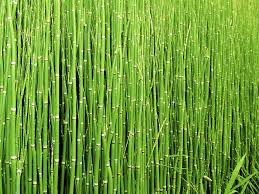What are horsetails and their features?« Back to Questions List
|
Horsetails are simple plants that thrive in waste places around much of the globe. It is also called equisetum. They have slender green side branches that grow from the joints or nodes, along the main stem producing a resemblance to a horse tail. The stems are hollow except at the joints, where they are ringed by tiny scale like leaves.There are only limited number of leaves on horsetails. Leaves are non-photosynthesis. Photosynthesis takes place in the plants’ green stems.
Horsetails grow mainly in temperate northern hemisphere areas consisting of North Africa Asia, Europe and North America. There are over 20 species of horsetail. The giant horsetail is the equisetum myriochaetum with a record height of 24 feet. This species grows tall and is evergreen. The hollow, jointed, ridged stems contain silicate and other minerals. As a result of silica deposits in some of their cells, the stems have a gritty feel.
Some species produce two kinds of shoots – those with cone like clusters of spore capsules and those lacking such structures. Many of them have cone like spore producing structures at the tip of the stems. Others send up special spore producing shoots that die back after the spores are shed. They don’t have flowers and do not produce seed. Reproduction of horsetails is through spores and not through seeds. It is attached to the ground via strong and very deep rhizome that gives rise to new stalks.
If eaten for long, some species become poisonous for the grazing animals. Although inedible to livestock, they are used by humans in folk medicines. Extracts were earlier used as herbal remedies. Some species have abrasive stems. This makes them useful in polishing tools. Before the inventions of chemical cleansers, these plants were used for cleaning utensils and wooden floors. Today they are seldom used for practical applications.
What is honey made of?Why don’t certain plants survive in one another’s company? |


